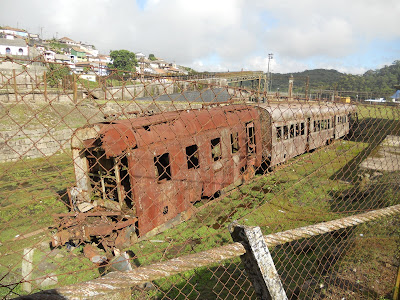Hoje, 29 de janeiro, fui até Paranapiacaba. As fotos mostram os trens que estão por lá abandonados, muitos raros, que merecem serem restaurados. Veja agora o ANTES e o DEPOIS:
Today, January 29th, I went to Paranapiacaba. The photos show the trains that are abandoned there, very rare, which deserves to be restored. Now see the BEFORE and AFTER:
Trem Unidade Diesel Elétrico "Estrela" DE nº2 - 1940
Fabricação: Armstrong
Ano: 1940
Formação: MC + R + RC
Curiosidades: Este trem fazia parte da "constelação" Cometa, Estrela, Planeta e Satélite. Durante testes, alcançou 150 km/h na serra e 165 km/h no planalto. Era idêndico ao Planeta e é o único no mundo desse modelo que ainda existe.
This train was part of the "Constellation", Comet, Star, Planet and Satellite. During tests, reached 150 km/h in the mountains and 165 km/h on the plateau. It was identical the Planet and is the only model in the world that still exists.
Trem Unidade Elétrico "Gualixo" - 1952
Fabricação: English Electric
Ano: 1952
Formação: RC + M + RC
Curiosidades: Parte do lote de três TUEs adquiridos pela EFSJ em 1952, para trens regionais. O Carro Motor (M) e um dos Carros Reboque com Cabine de Comando (RC) se encontram em Paranapiacaba. O outro Carro Reboque está no pátio de Piaçaguera. É o único desse modelo que sobrou.
Part three of the lot of electric units purchased by EFSJ in 1952 for regional trains. The Motor Car (M) and a trailer with the Cockpit (RC) are in Paranapiacaba. The other trailer is in the trailer Piaçaguera yard. It is the only model that is left.
Trem Unidade Elétrico "Carmen Miranda" Série 100 - 1937
Fabricação: Metropolitan Cammel
Ano: 1937
Formação: RC + M + RC
Curiosidades: Em Paranapiacaba se encontram dois Carros Reboque com Cabine de Comando, mas muitos carros desta série foram transformados em trens de socorro. Alguns ainda operam na CPTM, como vagão de manutenção. Esta série foi a primeira de TUEs no Brasil e foi adquirida pela EFCB. Operou no Rio de Janeiro, São Paulo e Belo Horizonte.
In Paranapiacaba are two trailers with Cockpit, but many cars in this series were transformed into relief trains. Some are still operating in the CPTM, such as maintenance car. This series was the first electric units of Brazil and was acquired by EFCB. Operated in Rio de Janeiro, São Paulo and Belo Horizonte.
Trem Unidade Elétrico "Alvorada" Série 200 transformado para Classe Única - 1954
Fabricação: Metropolitan Vickers
Ano: 1954
Formação: RC + M + RC
Curiosidades: Somente o Carro Motor se encontra em Paranapiacaba. Igual ao Série 100, muitos foram transformados em trens de Socorro. Ainda existem alguns desse modelo espalhados por aí.
Only the Motor Car is in Paranapiacaba. Same as 100 Series, many trains were transformed into Relief cars. There are still some scattered around this model.
Locomotiva Elétrica "Pão de Forma" Siemens Bo-Bo - 1958
Fabricação: Siemens
Ano: 1958
Rodagem: B-B
Curiosidades: Locomotiva Elétrica adiquirida pela EFCB em 1958, mais tarde foi transferida para a SR-4 em São Paulo, onde operava junto com as Escandalosas. Única deste modelo que sobrou.
Electric Locomotive acquired by EFCB in 1958, was later transferred to the SR-4 in SaoPaulo, where he operated along with the outrageous. Only this model is left.
Vagões Box de Madeira
Fabricação: Desconhecido
Ano: Anos 30
Truques: B
Curiosidades: Tipo de vagão muito comum na EFSJ e CPEF, hoje restam poucos. Por ser de madeira, não dura muito tempo ao ar livre. Em Paranapiacaba existem quatro sendo este da foto acima normal e os outros três modificados para manutenção da rede aérea:
Type of wagon and very common in EFSJ and CPEF, few are left today. Because wood does not last long outdoors. In Paranapiacaba there are four which is pictured above normal andthe other three modified for maintenance of overhead:
Outros Vagões
Além destes acima, ainda existem esses vagões, sendo dois que foram modificados para manutenção de rede aérea, um vagão gaiola, bastante raro, e um outro fechado:
Besides those above, there are still those wagons, and two that have been modified to electric wires maintenance, a liverstock wagon, very rare, and another closed:
Fotos do "Antes" tiradas do Google Imagens (algumas do Estações Ferroviárias).
Fotos do "Depois" tiradas hoje, por mim mesmo.





















